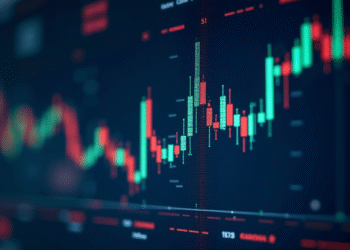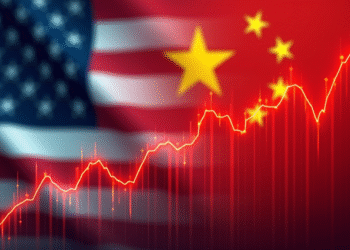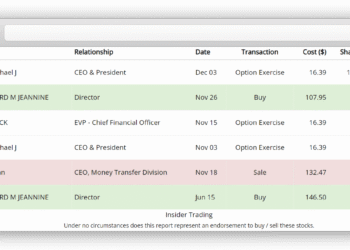In a dramatic turn of events, the dollar sinks to a 3-year low as anxiety over the escalating US-China trade war intensifies. The dollar index plummeted by 1.20% today, highlighting concerns that heightened tariff tensions could lead to economic instability and potential stagflation in the United States. With China effectively retaliating by raising tariffs on US goods, confidence in the dollar as a reliable reserve currency is rapidly eroding. Compounding the dollar’s struggles, a recent decrease in the University of Michigan’s consumer sentiment index has only deepened fears of a weakening economy. As the situation unfolds, the precious metals market has seen a rally, reflecting investors’ increasing appetite for safe-haven assets amidst growing economic uncertainties.
The recent depreciation of the dollar, marked by a significant drop to a 3-year low, underscores the profound impact of international trade relations on currency stability. The ongoing trade skirmishes between the US and China have not merely affected tariffs but have also spurred concerns over the broader implications for the American economy, including heightened risks of stagflation. Market dynamics are shifting as investors closely monitor changes in consumer sentiment and the behavior of the dollar index, further complicated by the recent rallies in precious metals. As analysts dissect these developments, the interplay of geopolitical factors and economic indicators continues to shape perceptions of the dollar’s value and its global standing.
Impact of US-China Trade War on Dollar Value
The ongoing US-China trade war is exerting significant pressure on the US dollar, driving it down to a 3-year low. As China raises tariffs on all American goods in retaliation for increased US tariffs, the dollar index has dropped sharply, reflecting a crisis of confidence among investors. The continued escalation of this trade conflict raises fears of prolonged economic instability, which could potentially lead to stagflation—characterized by stagnant growth and rising inflation. The specter of stagflation is particularly concerning, as it complicates monetary policy and may force the Federal Reserve to reconsider its interest rate strategies in an already weakening economy.
Moreover, the weakening dollar is not only a reflection of trade tensions but also of shifting consumer sentiment. Reports indicate a sharp decline in the University of Michigan’s consumer sentiment index, which has fallen to its lowest level in nearly three years. This decreasing confidence among consumers exacerbates fears of a commercial downturn, putting additional stress on the dollar. As investors seek refuge in other currencies or assets, particularly amidst fears of economic recoil from trade wars, this trend may persist unless a resolution is found.
Stagflation Risks and Economic Outlook
Recent warnings from notable economic figures, such as St. Louis Fed President Musalem, have spotlighted the significant risks of stagflation in the United States. The persistent trade battles have not only destabilized markets but have also led to higher inflation expectations, which rose sharply in recent reports. This rise in inflation expectations raises concerns over the purchasing power of consumers and could impact their spending behavior, contributing to a downward spiral in economic performance. If inflation persists while economic growth stagnates, the ramifications could be extensive, affecting employment, investment strategies, and international trade relationships.
As stagflation risks escalate, the Federal Reserve faces a daunting challenge. Despite easing producer prices, policymakers are cautioned against lowering interest rates too quickly due to potential inflationary pressures from tariffs and trade uncertainties. The balancing act of stimulating growth while controlling inflation sparks heated debates among economists regarding the best path forward. Observers note that a careful reassessment of monetary policies may be necessary to navigate these tumultuous conditions.
Dollar’s Susceptibility to International Market Dynamics
The vulnerability of the US dollar to international market dynamics has become increasingly apparent with the escalation of the US-China trade war. As tensions rise, foreign investors are re-evaluating their exposure to US assets, leading to a marked shift in investment strategies. These shifts are influenced by not only trade wars but also geopolitical events that can sway market perceptions and valuations. Given the rise of the euro and the yen, which have gained against the dollar during this period of unease, the dollar’s position as the world’s primary reserve currency could be challenged if these trends continue.
The current scenario further complicates the US dollar’s standing as global markets respond to perceived risks differently. For instance, the surging demand for safe-haven assets like precious metals amid rising tariffs reflects a global shift in investor sentiment. A declining dollar often propels precious metals like gold and silver higher, highlighting how intertwined economic policies and international relations have become. Investors might now be looking more critically at the dollar’s long-term viability as a stable asset in an uncertain global landscape.
Consumer Sentiment Index: An Indication of Economic Health
The University of Michigan’s consumer sentiment index is often viewed as a critical barometer of economic health, reflecting consumers’ perceptions of their financial conditions and the economy at large. Recently, the index experienced a significant drop, hitting a 2-3/4 year low, which raises red flags about the robustness of consumer spending—an essential component of economic growth. Such declines in consumer sentiment often lead to decreased spending and investment, further exacerbating fears of recession amid rising inflation.
A weakening consumer sentiment index aligns with concerns surrounding the current trade environment and its implications for the economy. High inflation coupled with stagnant growth could lead consumers to curtail expenditures, which would negatively impact overall economic activity. Policymakers and economists are closely watching these indicators, as shifts in consumer behavior can provide insights into future economic movements and necessary fiscal responses.
Federal Reserve’s Dilemmas Amid Economic Uncertainty
As the dollar sinks to a 3-year low amidst growing economic uncertainties, the Federal Reserve’s policy-making landscape is fraught with dilemmas. Amidst escalating stagflation risks, Fed officials must navigate between tempering inflation and stimulating economic growth through monetary policy. Some central bank leaders have recently emphasized the need to maintain caution with rate adjustments, fueling discussions about the potential inflationary impact of ongoing tariffs. The delicate balance requires the Fed to adopt a forward-looking approach to monetary policy, one that carefully considers external shocks and domestic economic indicators.
Hawkish comments from central bank leaders, including assertions regarding the inflationary impacts of tariffs, signal that the Fed may opt against aggressive rate cuts, even as consumer concerns mount. With consumers facing increased prices and declining confidence, the Fed’s next steps will be crucial in determining not just the fate of the dollar, but the overall economic trajectory. An erratic approach could widen the gap between inflationary expectations and economic growth, leaving the Fed in a difficult position amid heightened scrutiny.
Precious Metals Rally: Safe Havens Amidst Market Turbulence
As the dollar continues its decline, precious metals have emerged as a favored choice among investors seeking safe haven assets. The recent rally in gold and silver prices speaks volumes about investor sentiments amidst market turbulence fueled by the US-China trade conflict. With the dollar weakening, many investors view gold as a stable alternative that traditionally holds its value during economic uncertainty. As geopolitical risks also spring up, demand for gold and silver is likely to soar, positioning these metals as essential hedges against economic instability.
Additionally, the current surge in precious metals is underlined by significant fund movements, with increased investments in gold ETFs indicating a broad-based shift towards physical assets. This inclination towards precious metals not only reflects a reaction to immediate economic threats but also underscores long-term fears of inflation, which could rise in the wake of tariff-induced pricing pressures. As market participants look for resilience in their portfolios, the ongoing rally in precious metals is poised to continue, particularly if economic indicators point towards persistent inflation in the coming months.
Geopolitical Factors Influencing Currency Markets
The geopolitical landscape significantly influences currency markets, and current events like the US-China trade war are a prime example. Heightened tensions have not only affected trade balances but have also driven shifts in investor priorities. Currency values are often swayed by perceptions of political stability and economic viability, which means that ongoing conflicts can lead to volatile market conditions. As countries engage in tit-for-tat tariffs, currencies like the dollar become more susceptible to declines against perceived safe havens like the yen and euro.
Moreover, geopolitical concerns extend beyond just US-China relations, with events in the Middle East and other regions altering investment flows as well. Increased volatility can result in larger swings in currency values, putting even more pressure on the dollar as it struggles to sustain its role as the world’s leading reserve currency. As investors assess risks and opportunities, they may lean towards currencies that are perceived to remain stable amidst such uncertainties, further exacerbating the challenges for the dollar.
Market Reactions: Currency Pair Adjustments
In light of the dollar’s recent performance, currency pairs are experiencing notable adjustments. The euro has notably strengthened against the dollar, reflecting a broader confidence in the Eurozone’s prospects as it remains less affected by the US-China trade conflict. The dollar’s depreciation has opened up opportunities for other currencies, allowing them to capitalize on the weakness of the dollar amid rising geopolitical tensions. Currency traders are closely monitoring these shifts, as changes in valuation can have substantial implications for trade dynamics and capital flows.
In contrast, the Japanese yen is experiencing an upward trajectory as increased demand for safe havens peaks amongst investors. The yen’s strength against the dollar underscores the flight-to-quality phenomenon during times of uncertainty, where investors seek the relative stability of currencies perceived as less vulnerable to trade war repercussions. As the situation progresses, currency pairs will continue to reflect the evolving narrative of international trade relationships and economic health, allowing for strategic trading opportunities.
Frequently Asked Questions
What does it mean when the dollar sinks to a 3-year low?
When the dollar sinks to a 3-year low, it indicates that the dollar index, which measures the value of the dollar against a basket of foreign currencies, has significantly decreased. This can reflect economic instability, decreased foreign investment confidence, or negative geopolitical events, such as the US-China trade war, which can also influence investor sentiment and market dynamics.
How has the US-China trade war impacted the dollar index?
The escalation of the US-China trade war has contributed to the dollar index sinking to a 3-year low. Increased tariffs imposed by China on US goods, in retaliation to US tariffs, raise concerns about economic prospects, leading to diminished confidence in the dollar as a reserve currency and a potential sell-off of dollar assets by foreign investors.
What role do stagflation risks play in the dollar sinking to a 3-year low?
Stagflation risks, which refer to the potential for stagnant economic growth coupled with high inflation, have exacerbated the dollar’s decline to a 3-year low. Concerns that tariffs might raise inflation while weakening the labor market can undermine confidence in the dollar, prompting investors to seek alternative assets.
How does the consumer sentiment index affect the dollar’s value?
The consumer sentiment index, which measures how optimistic or pessimistic consumers are regarding the economy, can directly influence the dollar’s value. A lower-than-expected consumer sentiment index, such as the recent drop to a 2-3/4 year low, can indicate weaker economic outlooks, leading to further declines in the dollar as investors react to potential economic slowdowns.
Why are precious metals rallying as the dollar sinks to a 3-year low?
Precious metals are rallying as the dollar sinks to a 3-year low due to increased safe-haven demand amid economic uncertainty caused by the US-China trade war. As the dollar weakens, investors often turn to gold and silver as alternative assets, driving up their prices significantly.
What might the future hold for the dollar amid ongoing trade tensions?
The future value of the dollar amid ongoing trade tensions largely depends on the resolutions and developments of the US-China trade war. If tensions escalate further or if stagflation risks materialize, the dollar may continue to face downward pressure. Conversely, any positive developments could lead to stabilization and recovery in the dollar index.
How do geopolitical risks affect the dollar and precious metals?
Geopolitical risks, such as conflicts in the Middle East, heighten demand for safe-haven assets like precious metals while simultaneously contributing to a decline in the dollar’s value. Heightened uncertainty makes investors wary of holding dollars, thus pushing them towards gold or silver as safer investments.
| Key Points | Details |
|---|---|
| Dollar Index Decline | The dollar index dropped by 1.20%, reaching a 3-year low. |
| US-China Trade War Impact | Increased tariffs from China on US goods from 84% to 125% in retaliation for US tariffs. |
| Confidence Crisis | The dollar’s status as a reserve currency is threatened, leading to liquidation of dollar assets. |
| Consumer Sentiment Down | University of Michigan’s sentiment index fell to a 2-3/4 year low of 50.8. |
| Inflation Expectations | 1-year inflation expectations jumped to 6.7%, the highest since 1981. |
| Growth in Precious Metals | Gold hits contract high; investors flock to safe havens amidst trade tensions. |
Summary
The dollar sinks to a 3-year low as tensions escalate in the US-China trade war, leading to increased tariffs and doubts regarding the US economy. This decline in the dollar index highlights the growing crisis of confidence among investors and signals potential stagflation risks. Additionally, the drop in consumer sentiment and rising inflation expectations further complicate the economic outlook. As investors pivot towards precious metals as a safe haven, the situation suggests that the dollar’s future may remain precarious amidst ongoing geopolitical tensions.













